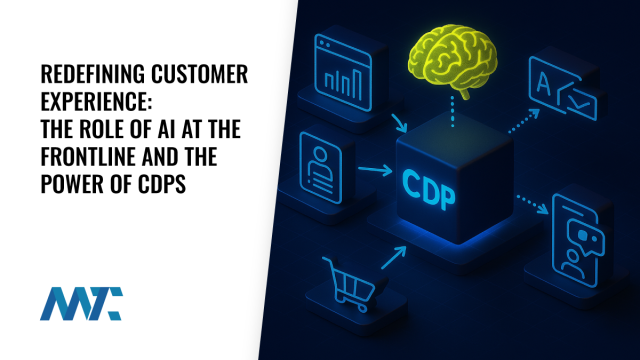Integrating Generative AI (GenAI) into customer-facing roles is revolutionizing the landscape of customer service. From online chatbots and interactive voice response (IVR) systems to fast-food drive-thrus, Gen AI-enabled systems are enhancing how businesses interact with their customers. A notable example is Yum! Brands, the parent company of Taco Bell, Pizza Hut, and KFC, partnering with NVIDIA AI to implement AI-driven order-taking solutions aimed at revolutionizing the drive-thru experience.
As a professional in Marketing Technology (MarTech), I view this trend as more than mere automation; it represents a fundamental shift in delivering Customer Experience (CX). Technologies like Customer Data Platforms (CDPs) are pivotal in ensuring these AI implementations are successful, providing a seamless and personalized customer journey.
How AI-Powered Customer-Facing Roles Benefit Companies
Customer interactions are critical moments where brand perception is formed. Integrating AI into these touchpoints offers several advantages:
Speed and Efficiency: AI-powered systems can process multiple customer interactions simultaneously, reducing wait times and increasing throughput. For instance, AI in drive-thrus can handle orders swiftly, minimizing customer queues and enhancing satisfaction.
Consistency: AI ensures uniform service delivery by adhering to predefined protocols, eliminating variability caused by human factors. This consistency reinforces brand reliability and trustworthiness.
24/7 Availability: AI-driven chatbots and virtual assistants (VA) provide round-the-clock support, catering to customer inquiries beyond standard business hours. This accessibility improves customer engagement and loyalty.
Cost Optimization: By automating routine tasks, AI reduces the need for extensive human resources, leading to significant cost savings. These resources can then be reallocated to more strategic initiatives.
However, the successful integration of AI transcends technology; it necessitates a strategic approach to experience orchestration.
Recent Successful Case Studies
Several organizations have successfully implemented AI in customer-facing roles:
Taco Bell, Pizza Hut, KFC: Partnered with NVIDIA to introduce AI-driven voice assistants for order-taking to improve accuracy and efficiency in drive-thru operations.
Best Buy: Deployed a Best Buy humanizes the customer support experience with troubleshooting, delivery scheduling, and service management, enhancing the overall customer experience.
NatWest: Collaborated with OpenAI to strengthen customer support through large language model-powered assistants (LLM), improving response times and service quality.
Wendy’s: Launched FreshAI to manage drive-thru orders, aiming to expedite service while maintaining employment levels, demonstrating AI’s role in augmenting human labor.
Pitfalls to Avoid in AI Integration
While AI offers numerous benefits, organizations must navigate potential challenges:
Lack of Human Escalation: Ensure that customers can seamlessly transition to human agents when AI cannot resolve complex issues, preventing frustration and dissatisfaction.
Generic Experiences: Avoid impersonal interactions by integrating AI with CDPs to leverage customer data for personalized engagements.
Privacy Violations: Maintain strict adherence to data privacy regulations by managing customer data responsibly and transparently.
Over-Reliance on AI: Balance automation with human touchpoints to preserve empathy and understanding in customer interactions, recognizing that AI should augment, not replace, human engagement.
The MarTech Perspective: The Critical Role of CDPs
Customer Data Platforms (CDPs) have immense potential to serve as the connective tissue between AI systems and customer-facing experiences. However, most of the CDP providers have not yet fully caught up with the rapid pace of Gen AI innovation. While the AI models powering chatbots, voice assistants, and recommendation engines have evolved rapidly, the underlying data infrastructure that fuels them—namely CDPs—often lags in readiness, integration, or activation maturity.
Case Studies where CDPs have transformed customer experience in recent years:
Burger King: Ran the iconic Whopper Detour campaign using mParticle by Rokt CDP to combine geofencing, mobile app behavior, and personalization in real-time. The campaign cleverly redirected McDonald’s app users to the Burger King app when near a McDonald’s location, offering them a Whopper for one cent—driving massive app downloads, engagement, and one of the most successful location-based marketing activations to date.
Subaru Corporation: Used Treasure Data’s CDP to unify online and offline data from dealers, CRM, and digital channels. This enabled personalized customer engagement and improved dealer sales enablement by delivering timely messaging based on customer intent signals.
TSB Bank: Powered by Adobe Experience Cloud’s AEP CDP, TSB achieved real-time personalization by unifying customer profiles across channels and enabling their AI engine (Sensei) to tailor messaging and product offers during key digital touchpoints.
Canadian Tire Corporation: Partnered with ActionIQ to orchestrate data-driven campaigns across in-store and digital journeys while putting Privacy at the forefront. The CDP allowed centralized control of segmentation, which improved ROI on targeted campaigns and ensured consistency in CX across divisions.
Untapped Potential of CDPs in Implementing Gen-AI Powered Use Cases
CDPs can be transformative when leveraged effectively in AI deployments. Below are several foundational ways CDPs enhance AI-powered customer interactions:
Unified Customer View: CDPs aggregate data from various channels—websites, mobile apps, in-store systems—to create comprehensive customer profiles. This consolidation enables AI systems to access accurate and holistic information during interactions.
Real-Time Personalization: Leveraging unified data, AI can tailor interactions based on individual customer preferences and behaviors, delivering personalized experiences that resonate and foster loyalty.
Privacy Management: CDPs manage customer consent and data privacy preferences, ensuring that AI interactions comply with regulations such as GDPR and CCPA, thereby maintaining customer trust.
Intelligent Routing: In IVR systems, CDPs analyze customer data to predict intent and route inquiries to the most appropriate resource, whether AI-driven or human, optimizing resolution efficiency.
Integrating CDPs with AI transforms customer interactions into context-aware, intelligent engagements that enhance satisfaction and drive business success.
Final Thoughts
The integration of AI into customer-facing roles signifies a transformative shift in customer service, offering enhanced efficiency, personalization, and accessibility. For professionals in Marketing Technology, leveraging AI in conjunction with Customer Data Platforms is essential to orchestrate intelligent, data-driven customer experiences. By thoughtfully implementing AI and addressing potential pitfalls, organizations can elevate their customer interactions, fostering loyalty and driving sustained growth.
©2025 DK New Media, LLC, All rights reserved | Disclosure
Originally Published on Martech Zone: Redefining Customer Experience: The Role of AI at the Frontline and the Power of CDPs

